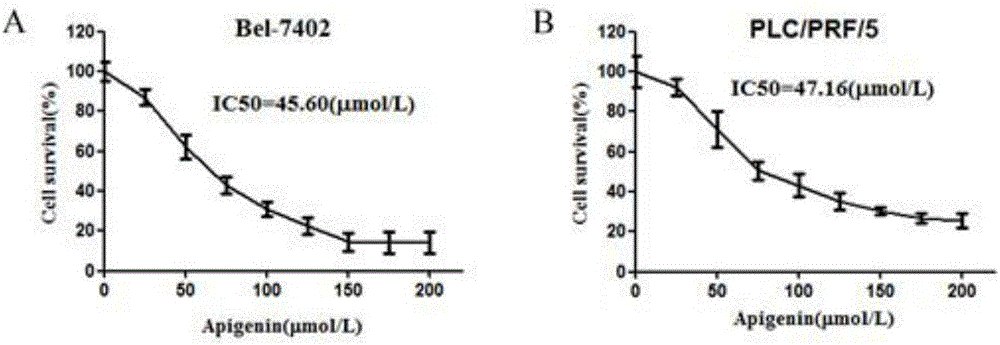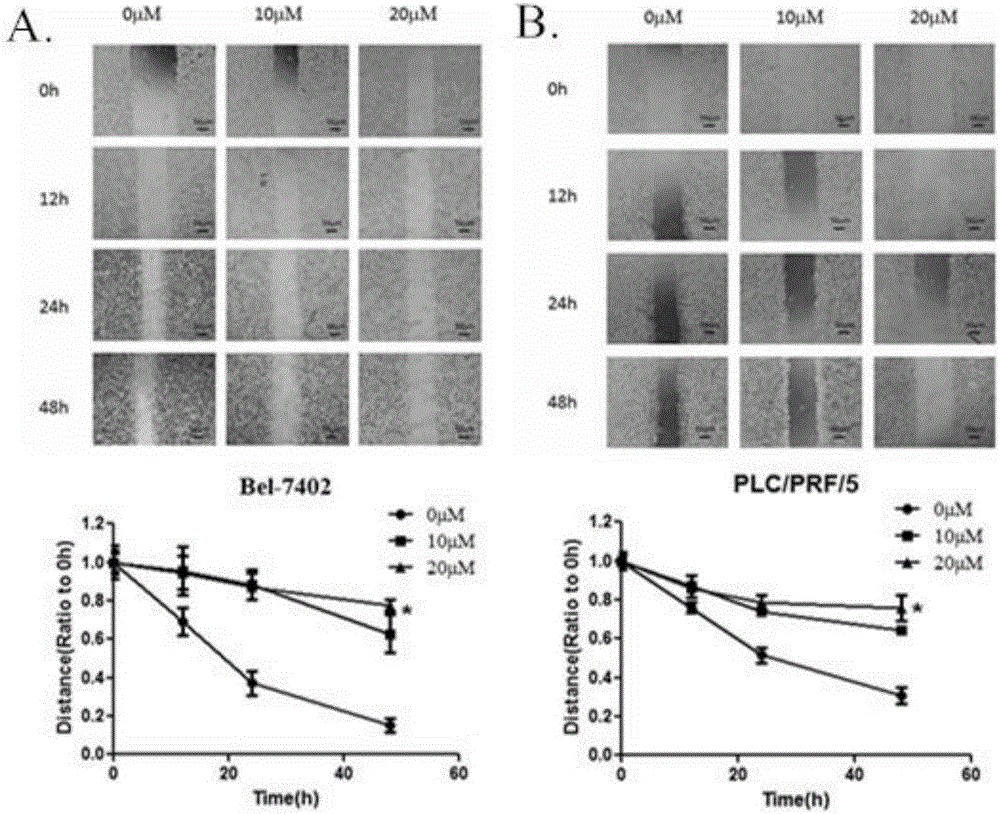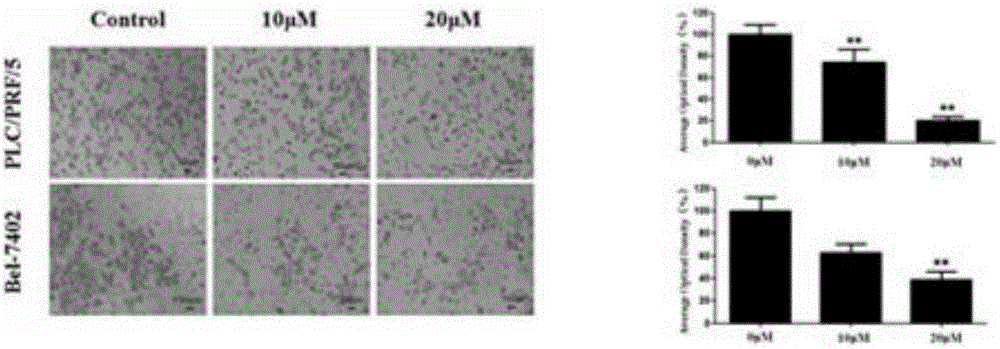Applications of apigenin for preparation of medicines inhibiting liver cancer epithelial-mesenchymal transition
A technology for epithelial cells and liver cancer cells, which is applied in the field of medicine and can solve the problems of unexplained biological mechanism and no discovery of the inhibitory effect of apigenin on the epithelial cell-mesenchymal transition of liver cancer cells.
- Summary
- Abstract
- Description
- Claims
- Application Information
AI Technical Summary
Problems solved by technology
Method used
Image
Examples
Embodiment 1
[0056] Embodiment 1 (apigenin detects the inhibitory effect on the proliferation of liver cancer cell lines Bel-7402 and PLC-PRF-5)
[0057] Experiment method: MTT colorimetric method
[0058] The specific experimental steps are as follows: different liver cancer cells were inoculated on 96-well culture plates, and the cell density was 5×10 3 pcs / well, then placed at 37°C, CO 2 (5%) overnight in the incubator. The next day, the culture medium was discarded, and cell culture medium containing 0, 25, 50, 75, 100, 125, 150, 175, and 200 μM apigenin were added respectively. Placed at 37°C, CO 2 (5%) After culturing in an incubator for 48 hours, add 20 μL of MTT (concentration: 5 mg / mL) to each well and continue culturing for 4 hours. Then the culture solution was sucked out, and 150 μ L DMSO was added to each hole as a solvent to dissolve formazan. After dissolving, the absorbance at 490 nm was measured with a microplate reader, and the cell survival rate was calculated accord...
Embodiment 2
[0061] Example 2 (in vitro cell level detection of apigenin on the migration ability of liver cancer cell lines Bel-7402 and PLC-PRF-5)
[0062] Experimental method: cell scratch method
[0063] The specific experimental steps are as follows: inoculate different liver cancer cells in 24-well plates and culture monolayer cells to 100%, use the tip of a sterile pipette tip to make a 100 μm scratch blank area, discard the liquid, wash twice with 1×PBS, and add the concentration 0, 10, 20μM apigenin cell culture solution, placed at 37°C, CO 2 (5%) Cultured in an incubator for 48 hours, placed on an optical microscope at a fixed position to take pictures at 0 hours, 12 hours, 24 hours and 48 hours respectively, and recorded the changes in the distance between cells at both ends of the scratch.
[0064] Relative starting position ratio (Ratio to 0h) = S xh / S 0h ; Use Excel software to draw the cell migration distance-time curve, and each index is represented by mean ± standard d...
Embodiment 3
[0067] Example 3 (in vitro cell level detection of apigenin on the impact of liver cancer cells Bel-7402 and PLC-PRF-5 invasion ability)
[0068] Experimental method: Transwell method
[0069] The specific experimental steps are as follows: on ice, mix the medium and matrigel 1:2, add 50 μL of matrigel dilution to the Transwell chamber, and after the matrigel solidifies, inoculate different liver cancer cells in the Matrigel-covered Transwell chamber, the cell density 2×10 4 cells / well, 200 μL of cell suspension in each well, and the concentrations of apigenin in the cell suspension were 0, 10, and 20 μM, respectively. The cells were then placed at 37°C, CO 2 (5%) Culture in the incubator for 24 hours, take out the cells after 24 hours, fix with cold methanol for 15 minutes, remove the matrigel and cells in the chamber with a cotton swab, then stain the cells on the bottom of the chamber with crystal violet for 20 minutes, wash the cells with PBS after staining 3 times to r...
PUM
 Login to View More
Login to View More Abstract
Description
Claims
Application Information
 Login to View More
Login to View More - R&D
- Intellectual Property
- Life Sciences
- Materials
- Tech Scout
- Unparalleled Data Quality
- Higher Quality Content
- 60% Fewer Hallucinations
Browse by: Latest US Patents, China's latest patents, Technical Efficacy Thesaurus, Application Domain, Technology Topic, Popular Technical Reports.
© 2025 PatSnap. All rights reserved.Legal|Privacy policy|Modern Slavery Act Transparency Statement|Sitemap|About US| Contact US: help@patsnap.com



